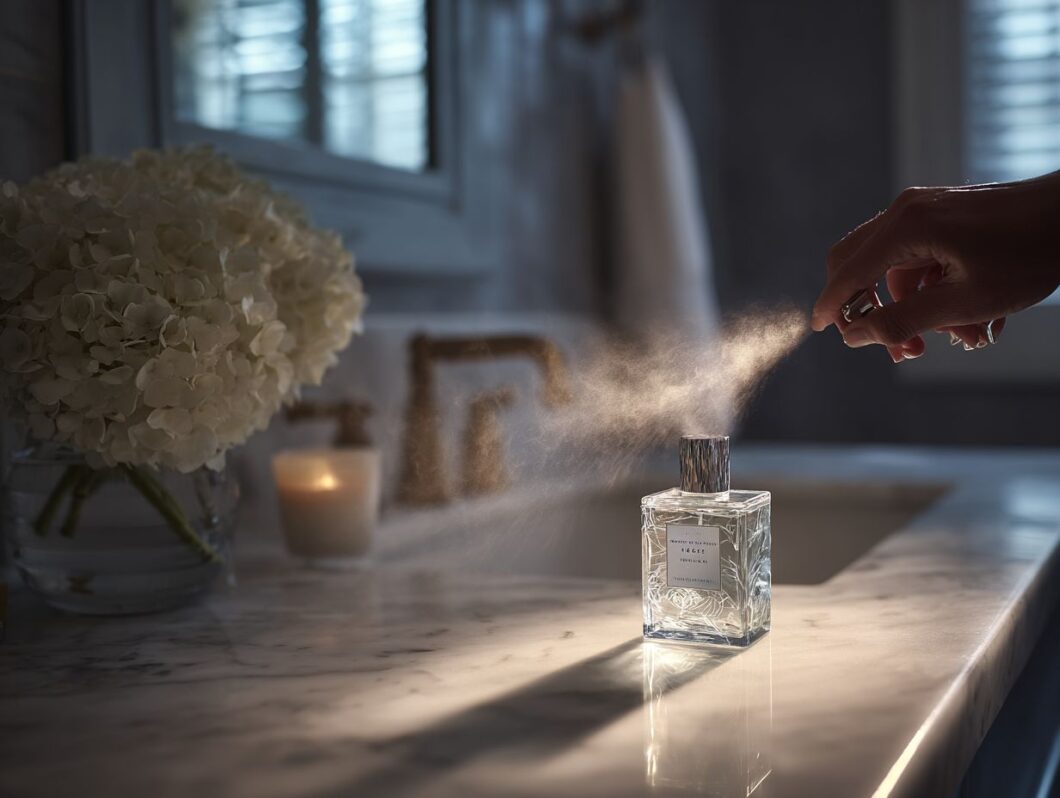Finding the perfect balance in perfume application can be tricky; excessive perfume can overwhelm the senses, while underapplying may leave you scentless. Whether you prefer a floral fragrance or a fresh cologne, mastering the art of refreshing your scent is essential. In this guide, we’ll share effective perfume application tips, including the best pulse points and the myth about rubbing your wrist. Discover how to keep your fragrance intact without the need for constant reapplication.
Key Takeaways:
Importance of Scent Management
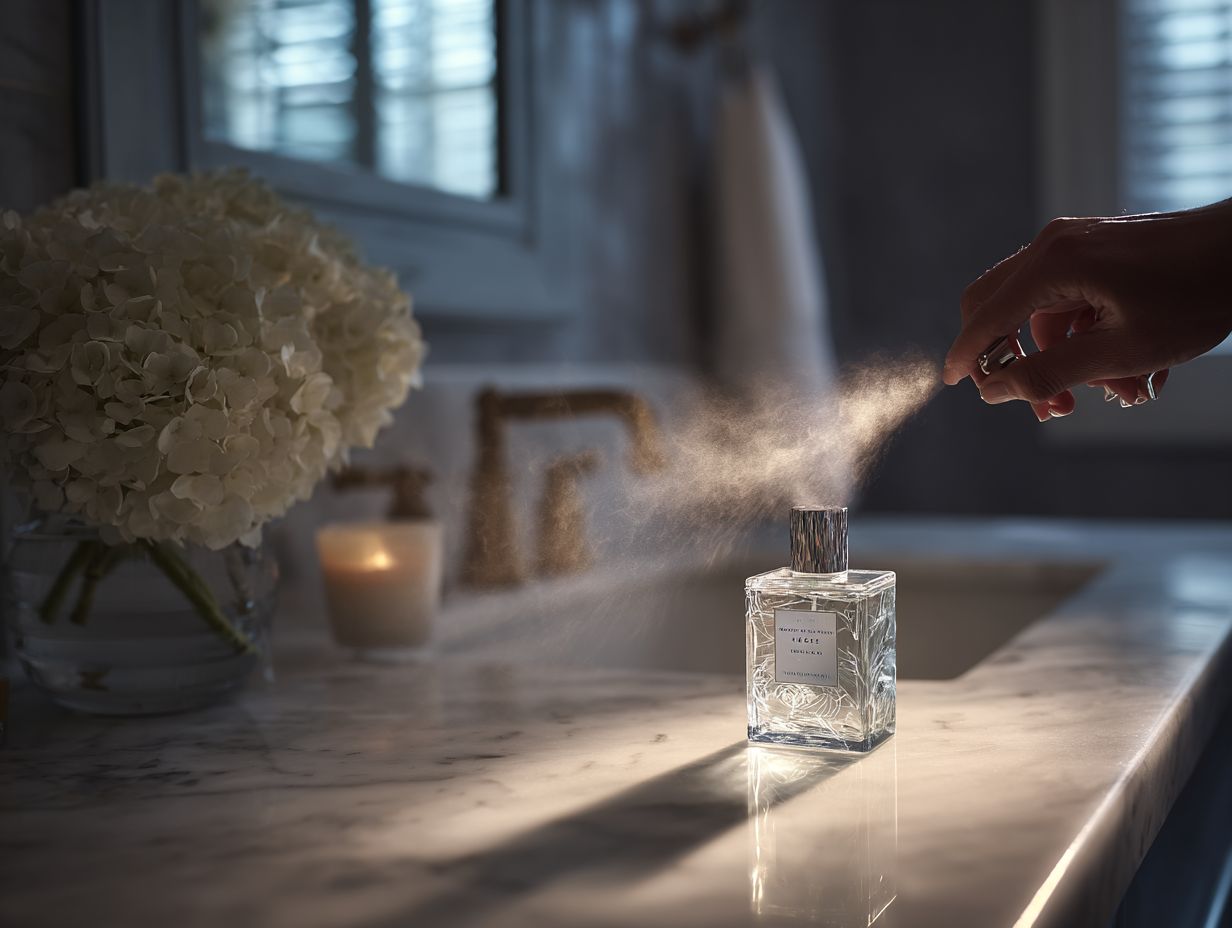
Effective scent management is essential for preventing issues such as scent fading and fragrance wear-off, ensuring that my fragrance remains appealing throughout the day. To enhance my personal presence, I find it beneficial to reapply my fragrance every four to six hours, especially after meals.
Using a moisture-rich lotion infused with the same scent helps create a base that locks in the fragrance for a longer duration, promoting fragrance binding.
Research indicates that 75% of emotions are triggered by smell, highlighting its significant role in social interactions.
By maintaining a consistent scent profile, I increase the likelihood of positive recognition, as studies show that familiar scents make individuals more approachable.
Understanding Fragrance Types
Understanding the differences in fragrance types is essential for making informed decisions regarding their application and longevity.
Perfumes vs. Eau de Toilettes
I understand that perfumes typically contain 20-30% fragrance oils, whereas eau de toilettes have only 5-15%. This difference in concentration significantly impacts their intensity and longevity.
When deciding between perfumes and eau de toilettes, I consider their concentration and the context in which I plan to use them. Perfumes, with their higher oil content, are ideally suited for evening wear or special occasions, lasting up to eight hours. On the other hand, eau de toilettes are lighter and more appropriate for daily wear or warmer climates, lasting around four to six hours.
For added versatility, I often choose a perfume for nighttime events, benefiting from perfume longevity, and an eau de toilette for casual outings. This approach allows me to enjoy the best of both worlds, depending on my needs.
Fragrance Families
Fragrance families-floral, oriental, woody, and fresh-play a crucial role in shaping how I perceive and enjoy scents. Each fragrance family has its own distinct characteristics.
- Floral fragrances, for instance, often present sweet and romantic notes like jasmine or rose, making them ideal for springtime wear.
- Oriental scents embrace warmth and exoticism, with spices and vanilla adding depth, which is perfect for evening events.
- Woody fragrances, characterized by notes of cedar and sandalwood, exude an earthiness that is particularly suitable for colder months.
- Fresh fragrances, featuring citrus or aquatic notes, deliver a crisp and invigorating experience, making them great choices for daytime wear.
When I select a fragrance, I consider my personal style, preferences, and the occasion to find my signature scent, applying perfume correctly.
Techniques for Refreshing Your Scent
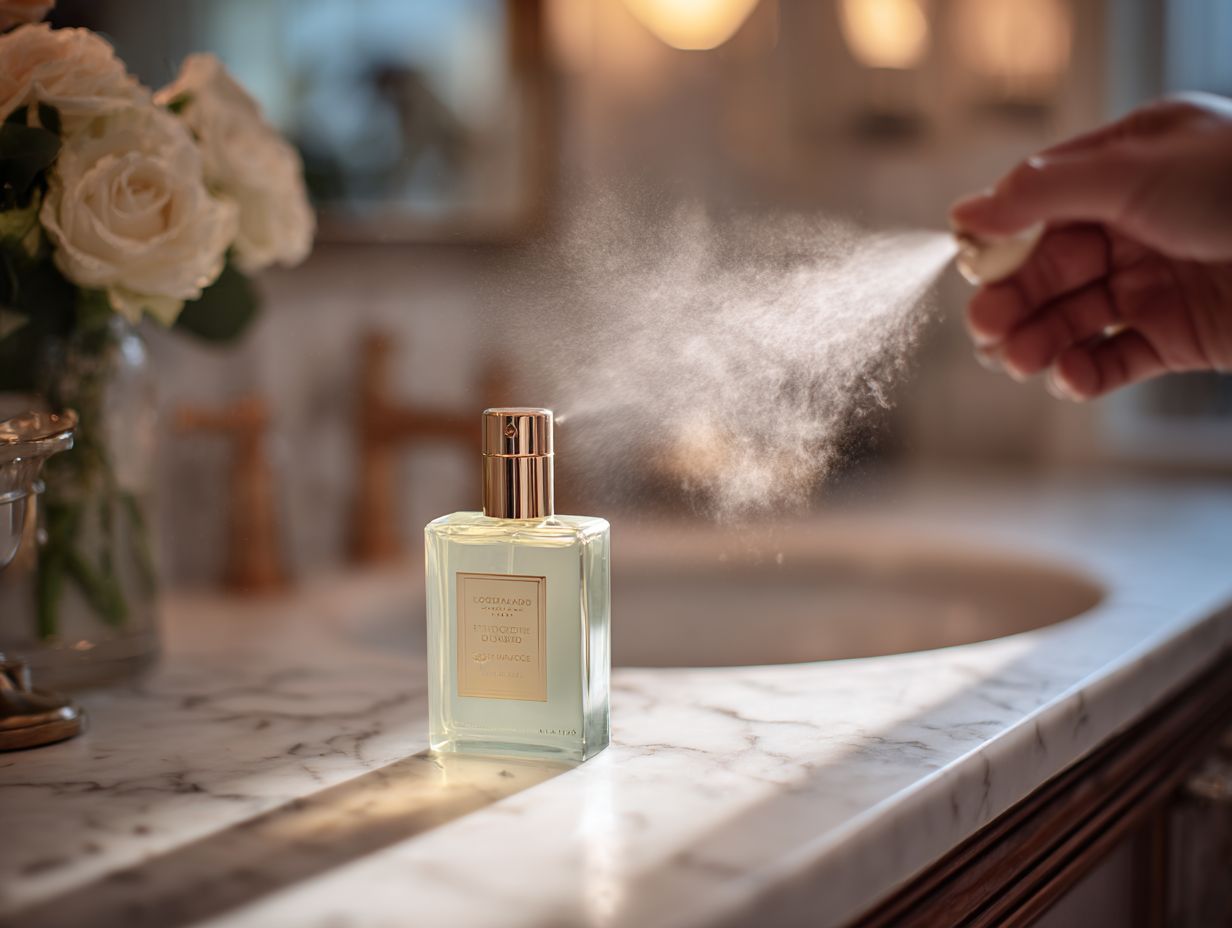
Implementing effective techniques for refreshing my scent can significantly extend the longevity of my fragrance throughout the day.
Layering Products and Scent Experience
Layering my fragrance with complementary scented products significantly enhances the overall scent experience, fragrance feedback, and prolongs its presence.
To effectively layer fragrances, I begin with a scented body lotion. For a subtle, nutty base, I opt for The Body Shop Almond Milk Body Butter. Next, I incorporate a matching shower gel, such as L’Occitane Almond Shower Oil; its warm, sweet notes enrich my overall scent profile. After that, I apply a deodorant like Dove’s Nourish Care, which is both gentle and lightly scented. Finally, I select a perfume, and Chanel Chance Eau Tendre provides a refreshing finish.
This layering method not only combines scents harmoniously but also hydrates my skin, ensuring maximum fragrance retention throughout the day.
Using Scented Body Products
Incorporating scented body products such as lotions and mists can significantly enhance my overall fragrance profile while also providing essential moisturizing benefits.
To effectively layer my fragrance, I select products with notes that complement my primary scent. For instance, if my main fragrance features floral notes, I opt for a jasmine or rose-scented lotion to achieve a harmonious blend.
Brands like The Body Shop offer body mists infused with a variety of fragrances, which allows me to customize my scent according to my preferences. I apply the lotion to pulse points-such as my wrists and neck-and lightly spritz the body mist on my clothes. This approach not only prolongs the scent but also creates a delightful olfactory experience that lasts throughout the day.
Timing Your Application
I recognize that understanding when to apply my fragrance can significantly influence its longevity and overall impact throughout the day.
Best Times to Reapply
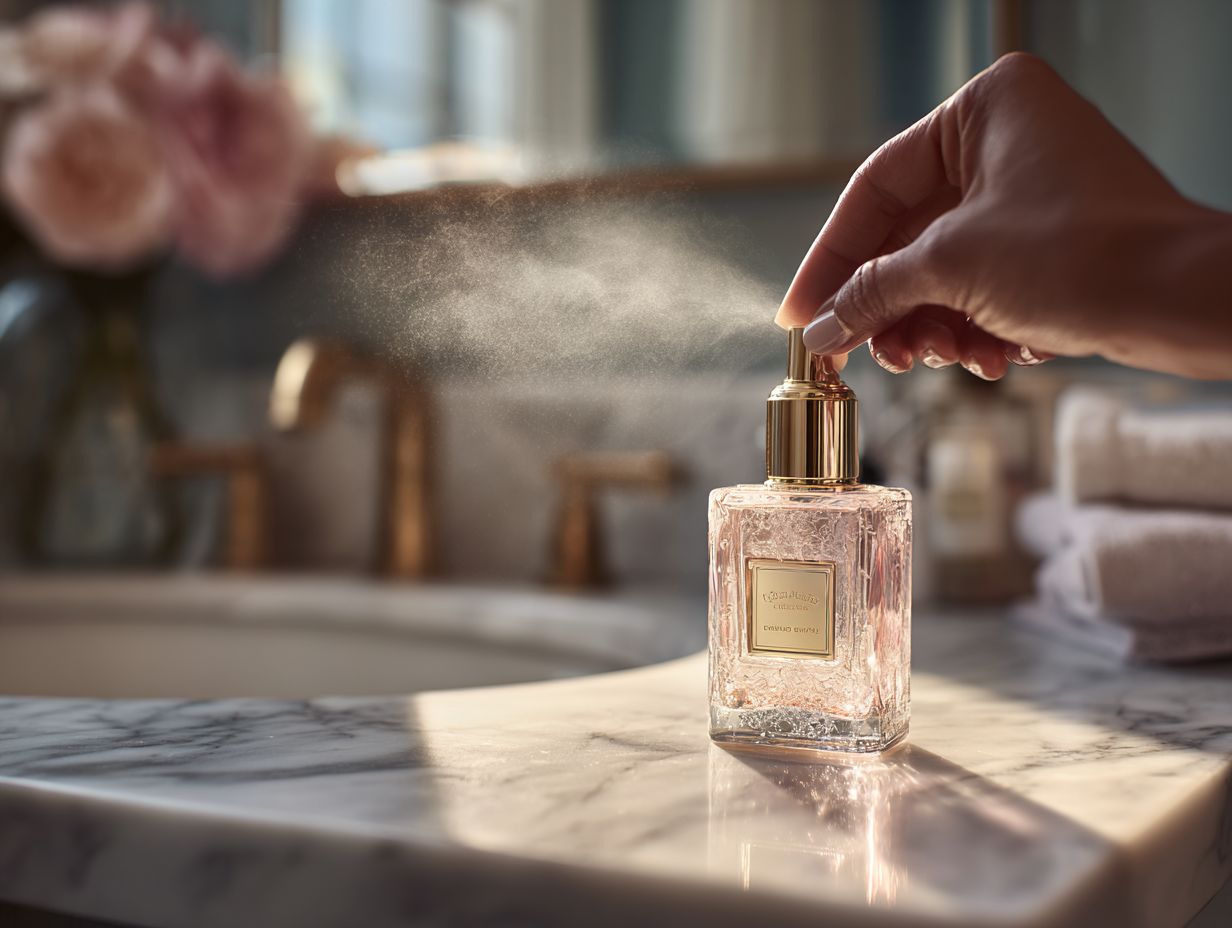
Reapplying fragrance every 4-6 hours is an effective strategy to combat scent fading, particularly during long days or in active environments. To optimize my fragrance experience, I take into account my daily schedule.
For example, if I start my day with a light citrus scent, I make it a point to reapply just before lunch and possibly again before any evening engagements.
I’ve noticed that floral fragrances typically last about 4-6 hours, while richer scents like amber or musk tend to linger longer, making them more appropriate for evening wear. Additionally, using an unscented body lotion before applying fragrance can enhance its adherence to my skin, thereby improving longevity.
I also remain mindful of my surroundings; humid or hot conditions can cause scents to dissipate more quickly.
Situational Considerations
Situational factors such as weather, activity level, and social settings significantly influence how I apply my fragrance, considering fragrance solutions.
In warmer weather, I prefer lighter and fresher scents, such as citrus or aquatic notes. For example, a spritz of lemon or bergamot feels refreshing and less overwhelming.
Conversely, during the colder months, I opt for richer and more robust fragrances, like amber or cedarwood, which provide warmth and depth-think deep vanilla or musk.
When engaging in physical activities, I find that a subtle spray on pulse points is the most appropriate approach. However, for formal events, I apply a few extra layers to ensure my scent projects well without being overpowering.
Storing Your Fragrance Properly
I understand that proper storage of fragrances is essential for preventing degradation and maintaining their intended aroma for years to come. Consider perfume storage tips for optimal results.
To store fragrances effectively, I always keep them in a cool, dark place, away from direct sunlight.
Utilizing opaque bottles is ideal, as they help shield the liquid from light, preserving fragrance molecules.
For optimal results, I store my fragrances at a consistent temperature between 60-70 degreesF. I also consider using a humidity-controlled environment and avoid areas with drastic temperature changes, such as bathrooms.
For those with a collection, I recommend a dedicated drawer or shelf with a soft lining to prevent accidental knocks and exposure to sunlight, ensuring that the original scent profiles are preserved for as long as possible.
Frequently Asked Questions
How can I refresh my scent without overapplying and avoiding fragrance application errors?
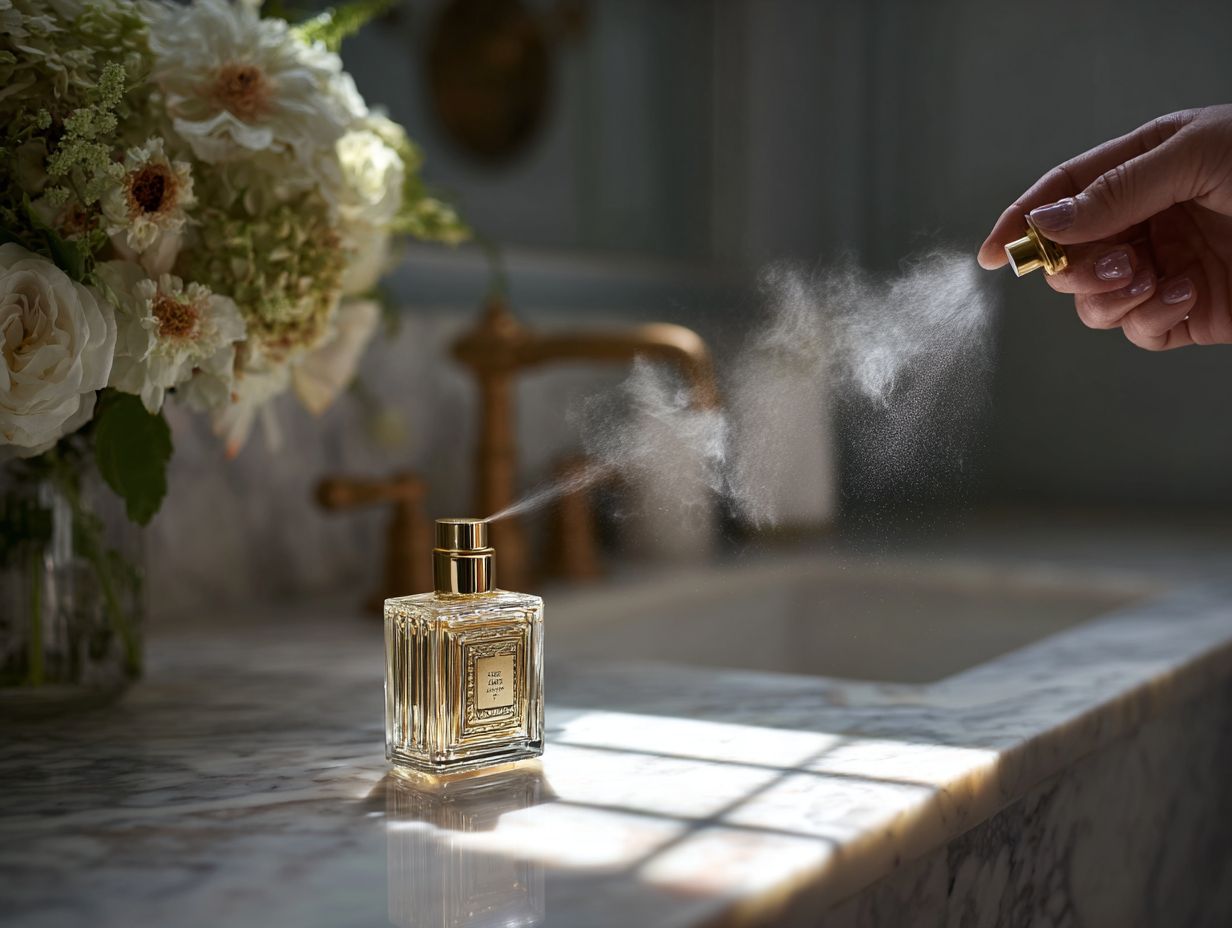
To refresh your scent without overapplying, start by spritzing your perfume in the air and walking through it. This will lightly distribute the scent without directly applying it to your skin.
What is the best way to touch up my scent throughout the day?
If you are wearing a stronger scent, apply a small amount of unscented lotion to your skin before spritzing your perfume. This will help dilute the scent and prevent overapplication.
Is it okay to layer different scents to refresh my fragrance?
It is not recommended to layer different scents to refresh your fragrance. This can create a confusing and overwhelming scent, and may also cause allergies or sensitivities.
Can I use scented body products to refresh my scent?
Yes, using scented body products can help to refresh your scent without overapplying, following proper perfume etiquette.
Just be mindful of the strength of the scent and use a small amount to avoid overpowering your perfume.
What are some other ways to refresh my scent without overapplying?
You can try using scented oils or perfume balms, which have a more subtle scent and can be easily applied to specific pulse points. You can also carry a small travel-sized perfume to touch up throughout the day.
Should I refresh my scent before or after a workout?
It is best to refresh your scent after a workout, as sweating can intensify the scent and may lead to overapplication. Wait until after your workout to reapply your fragrance.


